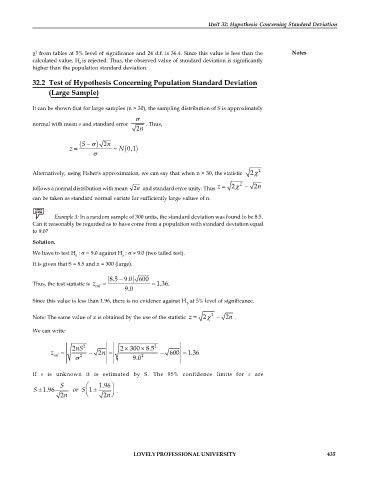Page 443 - DMTH404_STATISTICS
P. 443
Unit 32: Hypothesis Concerning Standard Deviation
2
c from tables at 5% level of significance and 24 d.f. is 36.4. Since this value is less than the Notes
calculated value, H is rejected. Thus, the observed value of standard deviation is significantly
0
higher than the population standard deviation.
32.2 Test of Hypothesis Concerning Population Standard Deviation
(Large Sample)
It can be shown that for large samples (n > 30), the sampling distribution of S is approximately
s
normal with mean s and standard error . Thus,
2n
(S s- ) 2n
z = ~ N )
(0,1 .
s
Alternatively, using Fisher's approximation, we can say that when n > 30, the statistic 2c 2
2
follows a normal distribution with mean 2n and standard error unity. Thus z = 2c - 2n
can be taken as standard normal variate for sufficiently large values of n.
Example 3: In a random sample of 300 units, the standard deviation was found to be 8.5.
Can it reasonably be regarded as to have come from a population with standard deviation equal
to 9.0?
Solution.
We have to test H : s = 9.0 against H : s 9.0 (two tailed test).
0 a
It is given that S = 8.5 and n = 300 (large).
8.5 9.0 600
-
Thus, the test statistic is z = = 1.36.
cal
9.0
Since this value is less than 1.96, there is no evidence against H at 5% level of significance.
0
2
Note: The same value of z is obtained by the use of the statistic z = 2c - 2n .
We can write
2nS 2 2 300 8.5 2
´
´
z = - 2n = - 600 = 1.36
cal 2 2
s 9.0
If s is unknown it is estimated by S. The 95% confidence limits for s are
S æ 1.96 ö
S ± 1.96 or S ç 1± ÷ .
2n è 2n ø
LOVELY PROFESSIONAL UNIVERSITY 435

